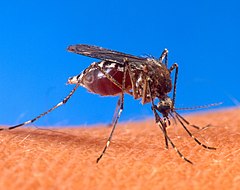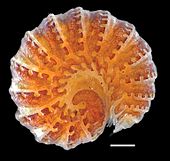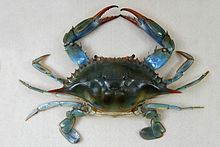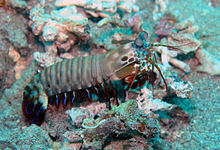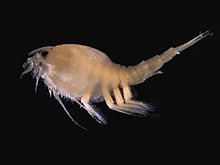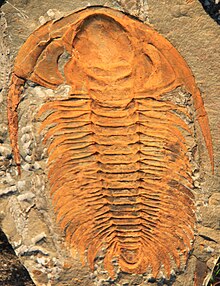
Branchiopoda is a class of crustaceans. It comprises fairy shrimp, clam shrimp, Diplostraca, Notostraca, the Devonian Lepidocaris and possibly the Cambrian Rehbachiella. They are mostly small, freshwater animals that feed on plankton and detritus.

Uniramia is a group within the arthropods. In the past this group included the Onychophora, which are now considered a separate category. The group is currently used in a narrower sense.

The subphylum Chelicerata constitutes one of the major subdivisions of the phylum Arthropoda. Chelicerates include the sea spiders, horseshoe crabs, and arachnids, as well as a number of extinct lineages, such as the eurypterids and chasmataspidids.

Arachnida is a class of joint-legged arthropods, in the subphylum Chelicerata. Arachnida includes, among others, spiders, scorpions, ticks, mites, pseudoscorpions, harvestmen, camel spiders, whip spiders and vinegaroons.

Millipedes are a group of arthropods that are characterised by having two pairs of jointed legs on most body segments; they are known scientifically as the class Diplopoda, the name derived from this feature. Each double-legged segment is a result of two single segments fused together. Most millipedes have very elongated cylindrical or flattened bodies with more than 20 segments, while pill millipedes are shorter and can roll into a tight ball. Although the name "millipede" derives from Latin for "thousand feet", no species was known to have 1,000 or more until the discovery in 2020 of Eumillipes persephone, which can have over 1,300 legs. There are approximately 12,000 named species classified into 16 orders and around 140 families, making Diplopoda the largest class of myriapods, an arthropod group which also includes centipedes and other multi-legged creatures.

Centipedes are predatory arthropods belonging to the class Chilopoda of the subphylum Myriapoda, an arthropod group which includes millipedes and other multi-legged animals. Centipedes are elongated segmented (metameric) creatures with one pair of legs per body segment. All centipedes are venomous and can inflict painful stings, injecting their venom through pincer-like appendages known as forcipules or toxicognaths, which are actually modified legs instead of fangs. Despite the name, no centipede has exactly 100 pairs of legs; the number of pairs of legs is an odd number that ranges from 15 pairs to 191 pairs.

Malacostraca is the second largest of the six classes of pancrustaceans just behind hexapods, containing about 40,000 living species, divided among 16 orders. Its members, the malacostracans, display a great diversity of body forms and include crabs, lobsters, crayfish, shrimp, krill, prawns, woodlice, amphipods, mantis shrimp, tongue-eating lice and many other less familiar animals. They are abundant in all marine environments and have colonised freshwater and terrestrial habitats. They are segmented animals, united by a common body plan comprising 20 body segments, and divided into a head, thorax, and abdomen.
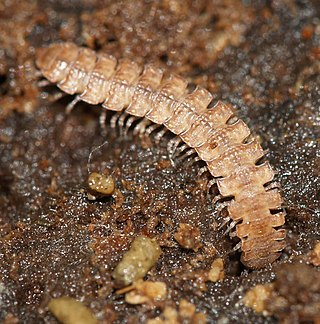
Chilognatha is a subclass of the class Diplopoda, which includes the vast majority of extant millipedes, about 12,000 species.

The telson is the hindmost division of the body of an arthropod. Depending on the definition, the telson is either considered to be the final segment of the arthropod body, or an additional division that is not a true segment on account of not arising in the embryo from teloblast areas as other segments. It never carries any appendages, but a forked "tail" called the caudal furca may be present. The shape and composition of the telson differs between arthropod groups.
In biology, a tagma is a specialized grouping of multiple segments or metameres into a coherently functional morphological unit. Familiar examples are the head, the thorax, and the abdomen of insects. The segments within a tagma may be either fused or so jointed as to be independently moveable.
The arthropod leg is a form of jointed appendage of arthropods, usually used for walking. Many of the terms used for arthropod leg segments are of Latin origin, and may be confused with terms for bones: coxa, trochanter, femur, tibia, tarsus, ischium, metatarsus, carpus, dactylus, patella.

The mouthparts of arthropods have evolved into a number of forms, each adapted to a different style or mode of feeding. Most mouthparts represent modified, paired appendages, which in ancestral forms would have appeared more like legs than mouthparts. In general, arthropods have mouthparts for cutting, chewing, piercing, sucking, shredding, siphoning, and filtering. This article outlines the basic elements of four arthropod groups: insects, myriapods, crustaceans and chelicerates. Insects are used as the model, with the novel mouthparts of the other groups introduced in turn. Insects are not, however, the ancestral form of the other arthropods discussed here.

Arthropods are invertebrates in the phylum Arthropoda. They possess an exoskeleton with a cuticle made of chitin, often mineralised with calcium carbonate, a body with differentiated (metameric) segments, and paired jointed appendages. In order to keep growing, they must go through stages of moulting, a process by which they shed their exoskeleton to reveal a new one. They are an extremely diverse group, with up to 10 million species.

Many species of arthropods can bite or sting human beings. These bites and stings generally occur as a defense mechanism or during normal arthropod feeding. While most cases cause self-limited irritation, medically relevant complications include envenomation, allergic reactions, and transmission of vector-borne diseases.

Pentazonia is a taxonomic infraclass of millipedes containing the pill-millipedes (Oniscomorpha) which can roll into a ball and the order Glomeridesmida which cannot. Defining traits (apomorphies) include divided sternites, a labrum with single median tooth, and an enlarged pygidium on the hind-most body segment. Pentazonia is in the dominant millipede subclass Chilognatha which have a calcified exoskeleton and modified sperm-transferring legs in males. In contrast to the Helminthomorpha – the other Chilognathan infraclass, the sperm-transferring legs are located on posterior body segments and known as telopods. Pentazonians are relatively short-bodied, with between 13 and 21 body segments. The Pentazonia contains one extinct order, Amynilyspedida, often referred to the Oniscomorpha.
The biological systematics and taxonomy of invertebrates as proposed by Richard C. Brusca and Gary J. Brusca in 2003 is a system of classification of invertebrates, as a way to classify animals without backbones.

Juliformia is a taxonomic superorder of millipedes containing three living orders: Julida, Spirobolida, and Spirostreptida, and the extinct group Xyloiuloidea known only from fossils.

The clade Multicrustacea constitutes the largest superclass of crustaceans, containing approximately four-fifths of all described crustacean species, including crabs, lobsters, crayfish, shrimp, krill, prawns, woodlice, barnacles, copepods, amphipods, mantis shrimp and others. The largest branch of multicrustacea is the class Malacostraca.





